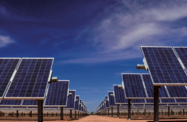
– Indonesia plans to establish a $4bn polysilicon industry
– Supply and demand issues saw polysilicon prices reach 10-year highs
– Greater production could help cut the cost of producing solar panels
– Emerging markets are increasingly investing in renewable energy

As the prices of solar power inputs reach 10-year highs, Indonesia is looking to boost solar panel manufacturing.
In late January the Indonesian government told international media that it plans to establish a $4bn polysilicon industry. Polysilicon is a key raw material in the production of solar panels.
Two plants are set to be constructed under the plans. The first, an $800m site in Batang, Central Java, will have an initial annual production capacity of 40,000 tonnes, with construction set to start in the third quarter of the year.
Meanwhile the second plant, a $3.2bn facility located in North Kalimantan, is expected to produce up to 160,000 tonnes of polysilicon per year when fully completed.
Rise in prices
The move comes after global polysilicon prices reached 10-year highs in 2021.
After prices plunged to as low as $7 per kg following a downturn in global demand associated with the Covid-19 pandemic in mid-2020, a number of polysilicon manufacturers either exited the market or scaled back production.
However, increasing demand for solar products globally has resulted in a worldwide supply shortage, which has sent polysilicon prices rising.
Prices rose to more than $36 per kg by December last year, and currently sit at around $33 per kg.
The problems in sourcing polysilicon have demonstrated some of the difficulties associated with post-pandemic supply chains, with demand for key goods and materials fluctuating dramatically over the past two years.
Ramping up production
In light of the global shortage, Indonesia is one of a number of global players looking to bolster supply.
At present, the polysilicon market is dominated by China, the US, Germany and South Korea, although there are significant operations in emerging markets like Malaysia, where South Korean chemicals company OCI has a 30,000-tonne-per-annum factory in the state of Sarawak.
In addition to Indonesia’s plans, producers in China have opened plants with a combined capacity of 160,000 tonnes in recent months, a significant addition to the current global capacity of around 620,000 tonnes.
The inauguration of these new facilities has boosted global capacity by around a quarter over the past few months, with the current figure expected to double by early 2023.
This will likely lead to a significant fall in polysilicon prices, reducing the cost both of producing solar panels and of the energy transition more broadly.
Indeed, Indonesia is hopeful that it will be able to offer polysilicon at below market prices, which could further increase the competitiveness of solar power.
Providing for the energy transition
The planned upgrade in polysilicon production comes as countries around the world are looking to bolster their renewable energy capacity.
Indonesia itself plans to install 5.3 GW of solar power capacity by 2030 and is encouraging businesses, factories and households to install their own solar panels.
Other emerging markets have also outlined sweeping renewable energy strategies.
For example, Saudi Arabia recently announced that it would invest SR380bn ($101.3bn) in renewable energy production by the end of the decade, while the UAE pledged to invest Dh600bn ($163.4bn) in renewables by 2050.
For Indonesia, developing a homegrown polysilicon industry would not only help to lower costs in its own solar energy rollout, but also give the country the opportunity to export a much-sought-after input that is key to the energy transition.



